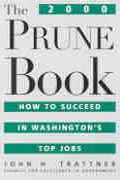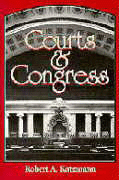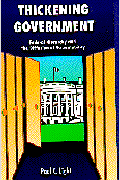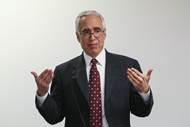With the announced resignations yesterday of Secretary of State Colin L. Powell and three of his colleagues, the vacancy rate of President Bush’s cabinet now stands at 40 percent. If history is any guide, that rate will soon start climbing among the positions that report to each cabinet secretary. By spring, Mr. Bush’s administration could have more empty chairs than appointees.
The political importance of filling those seats can hardly be overstated. Although the president has spoken of his grand plans for the future, it will not be long before the words “George Bush” and “lame duck” will start appearing in the same sentence. Mr. Bush has at best one year to set the agenda, and a second to get it enacted. The sooner he gets his appointees in place, the sooner the new team can start making the case.
Yet there are also the practical implications of so many open positions. Much of the work of the executive branch is carried out at the subcabinet level, but nominees to these positions are taking longer and longer to win approval. If the Bush administration wants its appointees to take office more quickly, it should work with Congress to streamline the appointments process.
The Bush administration faces two main problems filling the 300 to 400 Senate-confirmed positions that will soon be open for occupancy, if the limited history of second-term transitions is any guide. First, the presidential appointments process remains as cumbersome as ever. Every administration since 1961, first-term or second-term, has been later in filling its jobs than its predecessor, while every appointee has been more vulnerable to death by a thousand paper cuts.
Much of the frustration comes from efforts to “scandal-proof” the government by treating every nominee, in the memorable phrase of one former White House aide, as innocent until nominated. Despite repeated calls to make the process more efficient, appointees still have to fill out more than 60 pages of forms, answer more than 240 questions, and supply reams of financial data – sorted in every which way. They still have to supply the dates and places of birth of their mothers- and fathers-in-law, a complete inventory of all foreign travel, including short trips to Mexico and Canada, and the name of a high school classmate who can vouch for their character. Many of the questions date back to the McCarthy era and serve no purpose for increasing confidence in the nominee, but they must be answered nonetheless. At least one of the forms is best completed by typewriter.
It is little wonder that past appointees report so much frustration with the process. Nor is it any wonder that the vast majority of appointees seek outside help to navigate it; the forms often ask for the same financial information with just enough variation to require complete recalculation. Past appointees actually suffer from their prior service – the Federal Bureau of Investigation is obligated to cross-check their last set of forms against the new set, adding even more time to the process.
Cabinet nominees like Alberto Gonzales, who showed little interest in reorganizing the appointments process as White House counsel, are rarely affected by these problems. Their nominations move quickly through the Senate, often winning approval on Inauguration Day.
Rather, it is the subcabinet that bears the brunt of the frustration and delay. Nominees to the subcabinet, defined as any position below that of secretary, waited almost nine months on average to enter office in Mr. Bush’s first term. The federal hierarchy was not so much headless during the period as neckless. On July 11, 2001, for example, barely a quarter of the presidential appointees who would be involved in the war on terrorism had been either nominated or confirmed; on Sept. 11, the percentage was still well below half.
The second problem Mr. Bush faces is the sheer number of positions that he will have to fill. The presidential appointments process is like a concrete pipe; it can only handle a certain number of positions at a time. That number has been steadily increasing over the past half century. Convinced that more leaders equals more leadership, Congress and presidents have added layer upon layer, appointee upon appointee, to the bloated federal hierarchy.
Mr. Bush oversees more managers and more layers of management than any president before him. Whereas President John F. Kennedy appointed just 10 secretaries, 6 deputy secretaries and 87 assistant secretaries, Mr. Bush now appoints 15 secretaries, 24 deputy secretaries and more than 275 assistant secretaries. And the numbers do not include more than 2,500 appointees not subject to Senate confirmation. Absent a significant reduction in the number of political appointees, Mr. Bush will be filling the top jobs long after his window of opportunity has closed.
Mr. Bush does have one chance to address these problems. He could and should endorse the broadest possible version of the appointments process reform currently being considered by the House and Senate in the national intelligence legislation. Administration officials thus far have focused on the need to reduce the number of appointees subject to Senate confirmation hearings. But while such a reform may be sensible for less sensitive positions, it would not be sufficient: at least half of the delays come from the president’s own vetting process, which includes stops at the White House counsel’s office, the F.B.I., the Office of Government Ethics and the I.R.S.
If Congress acts fast enough, Mr. Bush’s new appointees can avoid at least some of the suffering that their predecessors endured. And if Mr. Bush cooperates, he stands a better chance of enacting his second-term agenda.








Commentary
Op-edLate for Their Appointments
November 16, 2004